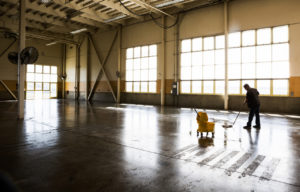 As a professional industrial cleaning services company, we often get asked: what’s the difference between cleaning, sanitizing and disinfecting? Here’s our answer.
As a professional industrial cleaning services company, we often get asked: what’s the difference between cleaning, sanitizing and disinfecting? Here’s our answer.
One of the mandates of a property or facility manager is to keep the building clean. It involves maintaining surfaces free from dust, bacteria, microbes, and any pathogens that put residents at risk.
It’s prudent to involve an industrial cleaning service provider for a professional and quality job. Service providers engage three crucial steps — cleaning, disinfecting, and sanitizing — for the job to meet industry standards. So, what’s the difference between the three processes. Let’s explore.
Cleaning
Cleaning is the process of removing dust and debris on the surfaces of buildings. Cleaning in isolation is not effective in buildings as it eliminates only 80% of germs and bacteria. You can clean a surface by washing, scrubbing, or rinsing it with water and soap.
Here’s a list of tools and supplies used in standard cleaning:
- Sponges and Scourers
- A mop and a bucket
- Cleaning brushes
- Microfibre cloths or dusters
- Multi-purpose cleaners
- Liquid Soap
Disinfecting
Disinfecting is the chemical process of killing germs and viruses to a high level of up to 99.99%. The disinfecting process can involve leaving the chemicals on the surface to allow the reaction to occur. Follow-up cleaning is required as disinfecting does not eliminate dirt.
How does disinfecting work?
The active ingredient in a disinfectant, for example, peroxide or ammonia, combines with pathogens — bacteria, fungi, mildew, or mould — and disrupts or destroys them. Manufacturers sometimes add a small component of disinfectants in detergents to enhance the results of industrial cleaning services.
Some common disinfectants include:
- Hydrogen Peroxide: A popular solution that breaks down into the natural elements of air and water. It’s therefore safe for the environment and users.
- Chlorine Compounds: A highly corrosive disinfectant used to clean resistant viruses and surfaces in contact with body fluids. It also an aggressive solution that requires caution while handling.
- Alcohols: They are effective when dissolved in water to kill a wide range of bacteria. Alcohol evaporates quickly, which is why it’s less effective for surface disinfection.
Sanitizing
Sanitizing is the process of lowering germ levels to an acceptable or safe level. You can sanitize a building by cleaning, disinfecting, sanitizing, or combining the three techniques. Unlike a disinfectant, a sanitizer lowers the germ levels in a faster and safer way. The acceptable or safe levels vary from one institution to another.
You can use a multi-purpose cleaner or sanitizer close to high contact areas in schools or office buildings. On the contrary, healthcare centres require an elaborate three-step plan — i.e., disinfecting followed by cleaning and sanitization of the surfaces.
Try our first class cleaning services
In an era where hygiene is paramount, you can’t afford to have a shoddy cleaning service. Top-class cleaning is what you need to avoid compliance issues or exposing your customers or employees to health risks. That said, Grandmother’s Touch is here to help you with industrial cleaning services. We’ve been in business since 1999, which makes us highly experienced and competent. Contact us today.

